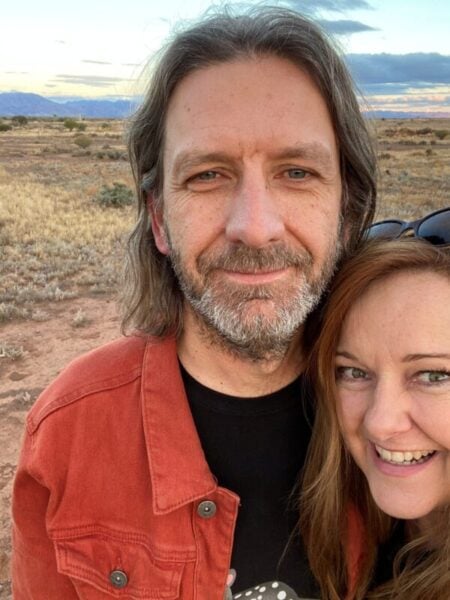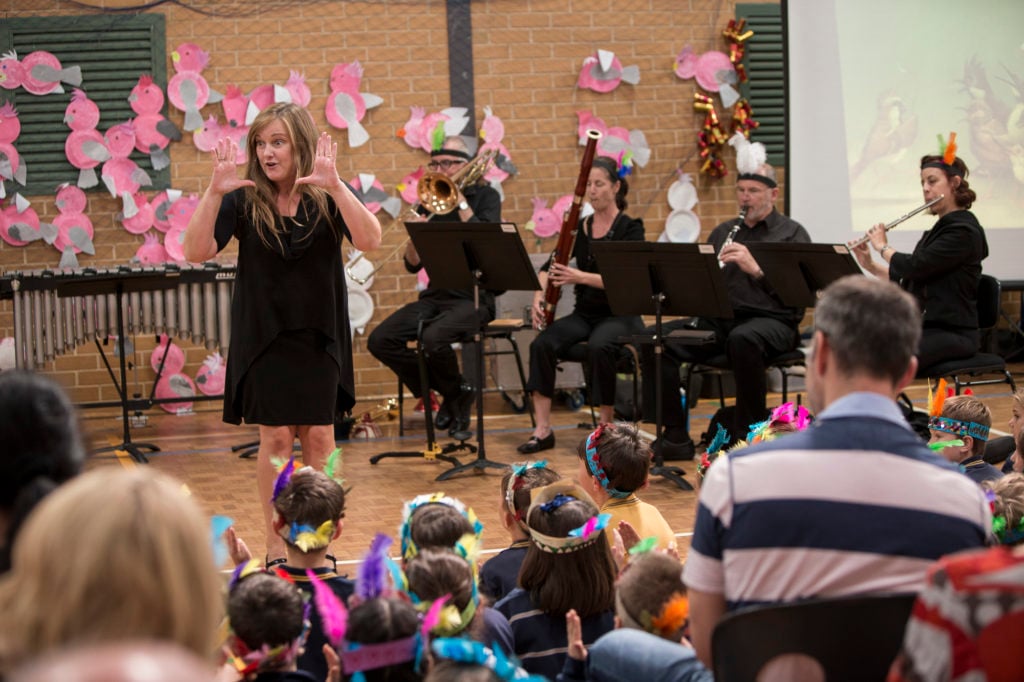Behind the Music with Mark and Susan Ferguson
- Behind the Scenes
- Meet the Artists

We caught up with composer Mark Ferguson (The Bush Concert, Herman and Rosie) and presenter Susan Ferguson to chat about their brand-new show Around the World. From how the idea took flight, to what makes it such a fun and interactive adventure, read on to discover what inspired the work—and what we hope students will take away from the journey.
How did your journey with the ASO Learning Program begin, and how long have you been working together as creative team? Has your collaboration evolved?
Mark: We’ve been working for many years performing in various combos in pop, jazz, big band and light classical music (we have been married since 1992!).
Susan is a Primary School Music teacher and she had been bringing our children to ASO children’s concerts since they were tiny. She started working for ASO learning programs with their Toddler Toe Tapper’s concerts in 2013, and she brought me in to write the arrangements/orchestrations (and a new song). I had worked with the ASO back in 2007 arranging their Gospel Messiah, so it wasn’t random nepotism!
Since then we have collaborated on a number of projects for the ASO!
Mark, after composing our beloved The Bush Concert, what excited you about this new project? Were there particular musical styles or instruments that shaped your approach this time around?
Mark: The Bush Concert and Herman and Rosie had really set parameters—the images and story dictated the music, the attitude, the musical story-telling. For this show I had to start from scratch, find a reason for the audience to go ‘Around the World’ which was challenging but very engaging and sent me on some very long research journeys.
With a title like Around the World I knew that I would be drawing on musical styles from East Asia, India, the Middle East and Africa—so I knew I would need a richly varied rhythmic, melodic, harmonic and timbral palette to ‘paint’ from.
As with most composers and orchestrators when writing for a chamber ensemble I aim to choose instruments that will give me the largest pitch range and broadest range of timbres but with the smallest number of instruments. I wanted to write for (French) horn as I hadn’t used it in the previous shows—and the orchestra has five of them!
How do you choose the right instruments or musical styles when writing for primary‑aged students?
Mark: I firstly choose instruments that work for the story. BUT…having all four instruments from the string section really helps young students to see and hear the relationship between high and low sounds and small and large instruments. Same with the woodwinds.
In a perfect world I would have used a whole percussion section but for ease of touring the drum kit and some extra auxiliary percussion covers the sounds required. I also think that having drums on the stage set in between traditionally ‘classical’ instruments provides a strong visual aid for students — the music is going to cover a lot of ground.
Around the World explores ideas of culture, environment, and change. How did you weave those themes into the music and storytelling?
Mark: I had come across Bar-tailed Godwits, the superheroes of migration (BTG’s in the show) in my reading over the years. They can be found right across the globe so their story speaks of the interconnectedness of us all, but it is also a local one too as BTG’s can be found here at our doorstop.
Importantly BTG’s and other migrating birds are at the coalface of the problems raised by climate change, pollution, habitat destruction and the clash between development and protecting the environment. Australia’s migrating birds have experienced a loss of 60-80% of their population in the last 30 years – that is a figure that is hard to ignore, so I thought that I would try to intertwine a strong environmental message into my story in the hope that children and their teachers will be engaged to interact with these problems.
What sort of impact do you hope that ASO Learning Program concerts make on students? What does this look like on both a day-to-day scale, as well as longer-term that may help shape who they grow to be?
Susan: I really hope the concerts can spark joy for the students and give them a lifelong love of music! My Nana taught me that if we have music in our life (in whatever form it takes) we will never be lonely, and that has always stayed with me.
Countless studies have confirmed what humans throughout history already knew intuitively: experiencing and sharing music with others does wonderful things for our minds and souls. The combination of words with music is such a rich medium: we remember words and stories so much more when they are connected to a melody.
The lyrics to catchy songs can remain in our brains for life. The words can come out at key moments and encourage us, helping us deal with situations in the schoolyard or the wider world. For many people it can just be a joyful thing to sing and dance: these little moments of silliness are also a great stress release and help us to connect with each other.
For example, my year 1 students (who were my guinea pigs for many of the Around the World activities and songs) will often spontaneously start singing one of the songs from the show whilst engaged in a totally unrelated activity. This heightens their connections with each other, engages their brains in different ways, and makes them happy!
Whether or not students decide they’d like to try learning an instrument after being involved in a concert, become a musician, or a future orchestra concert goer, their minds and ears will have been exposed to something different as they go on a musical journey with us. They will have learnt some new things about the world, its people and their role in it.

Applications for Around the World have now closed, but there are still exciting opportunities to engage your students with live orchestral music, including our incursion Circus of Instruments. Explore our upcoming events below!
The ASO Learning Program is generously supported by


